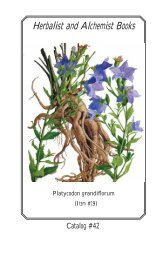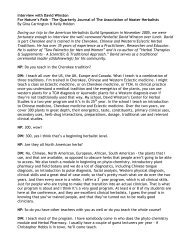MEDlCINAL PLANTS OF JAMAICA. PARTS 1 & 11.
MEDlCINAL PLANTS OF JAMAICA. PARTS 1 & 11.
MEDlCINAL PLANTS OF JAMAICA. PARTS 1 & 11.
Create successful ePaper yourself
Turn your PDF publications into a flip-book with our unique Google optimized e-Paper software.
Similar uses of the plant are described in Maya medicine and in addition the laex was used for sore eyes. In<br />
parts of Mexico other small Euphorbia spp. are used for this purpose. The B.P.C. 1934 described this species.<br />
which has been used with lobelia or senega to treat chronic bronchitis, asthma, hay fever and other respiratory<br />
troubles, as having a depressant action on the heart and on respiration. The plant has been considered laxative.<br />
(1, 2, 5, 7, 13, 15. 17, 19, 27, 37, 55, 56, 59).<br />
EUPHORBIA HYPERICIFOLIA L. Spurqe; Wart Weed.<br />
In Jamaica tea made by boiling this plant is regarded as useful in the treatment of marasmus in infanls.<br />
Githens states that the latex contains resins and euphorbon. The latter is said to be toxic. According to Wehmer<br />
a phenol-like substance, volatile oil, and a little alkaloid and glycoside are found in the shoots. (2, 7, 9, 10, 13,<br />
15, 24, 27, 37, 61, 62).<br />
EUPHORBIA THYMIFOLIA L. Spurqe; Wart Weed; Eyebright.<br />
Another small herbaceous spurge which is used in a similar way to those already mentioned. The plant has also<br />
been used as a vermifuge, as an astringent, to remove films from the eyes and as a laxative. (I, 9, 14, 15, 24, 37,<br />
39, 61).<br />
JATROPHIA GOSSYPIFOLIA 1.. Wild Cassada.<br />
A tea made with the leaves of the wild cassada is still used as a laxative. In Trinidad oil from the seeds<br />
provides a purge and the plant is also used by the Brazilian Indians to treat stomach upsets. (1, 2, 5, 7, 9, 15. 24,<br />
27. 28, 37, 48, 50, 62).<br />
MANIHOT UTILISSIMA Pohl. Cassava (Cassada); Manioc; Tapioca.<br />
In addition to the use of the bitter cassava for the preparation of starch. the grated tuber is said to make<br />
an excellent poultice for sores. This use, which persists, is recorded by the early writers such as Browne who<br />
says that in the case of very foul sores the cassava flour, still containing some of the juice, should be mixed up<br />
with pounded tobacco leaves. Barham recommends a poultice made with cassava bread, milk and sweet oil to<br />
ripen boils. The tubers are used in a similar manner in Africa. They contain phaseolunatin accompanied by an<br />
emulsin-like enzyme. The young leaves are sometimes boiled as greens. (I, 3, 5, 7, 15, 27, 37, 39, 50, 60, 61).<br />
PHYLLANTHUS NIRURI L. Carry-me-seed; Chamber Bitters; Chickweed; (Grenadines).<br />
In Jamaica the use of this species for the treatment of stomach disorders, is confirmed. In some parts of<br />
the West Indies it has a reputation as a malaria remedy. (2, 7, 9, 14, 27, 39, 61).<br />
RICINUS COMMUNIS L. Castor Oil Plant; Oil Nut.<br />
The leaves of the white-stemmed variety of Ricjnus communis are reported to make a bath which is<br />
efficacious in reducing pain and swelling in the joints. Hot ashes wrapped in a leaf of the castor oil plant were<br />
used by the Maya in the treatment of syphilitic sores and the crushed seeds provided a dressing for scabs on the<br />
arm or head. In India castor oil has been used as a dressing for skin diseases; it has also been recommended in<br />
cases of lumbago, rheumatism. piles and worms. (3, 5, 7, 8, 10, 15, 18, 22, 23, 24, 26, 27, 37, 38, 39, 50, 56, 61,<br />
62).<br />
FILICINEAE<br />
ADIANTUM TENERUM Sw. Maidenhair Fern; Black-stick Maidenhair.<br />
This species of maidenhair fern (and, perhaps. others) is used to make tea for colds. Beckwith recorded<br />
its use with a number of other plants for this purpose (see Anarcardium occidentale). A. villosum Land A.<br />
trapeziforme L. were thought demulcent and pectoral by old writers. Browne considered all Adiantum spp. to be<br />
light astringent vulneraries useful in pulmonary and cutaneous disorders. The tea is also thought to be "good for<br />
the heart". It may be of interest to note that A. capillus-veneris L. had a reputation in Europe as a remedy for the<br />
treatment of pulmonary catarrh. Some African tribes smoke the leaf for head and chest colds. The plant has also<br />
been used as an emmenagogue.







